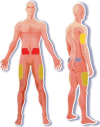Indian Injection Technique Study: Population Characteristics and Injection Practices
- PMID: 28289893
- PMCID: PMC5446372
- DOI: 10.1007/s13300-017-0243-x
Indian Injection Technique Study: Population Characteristics and Injection Practices
Abstract
Introduction: It was estimated that 3.2 million Indians with diabetes injected insulin in 2010, but little is known about the techniques used.
Methods: In 2015 we conducted an injection technique questionnaire (ITQ) survey throughout India involving 1011 patients. Indian values were compared with those from 41 other countries participating in the ITQ, known here as rest of world (ROW).
Results: Mean HbA1c was 8.6. BMI values in India were 1.5-3 units lower than in ROW depending on patient group, meaning the risk of intramuscular (IM) injections is high in India. The mean total daily dose (TDD) of insulin was lower in every category of Indian patient than in ROW, perhaps reflecting the lower BMI. Needle reuse, whether with pens or syringes, is much higher in India than ROW and so is the number of times the needle is used. The majority (56.8%) of Indian insulin users performed only 2 injections/day as opposed to ROW where 45% of patients performed at least 4 injections/day. Indian patients inject insulin in the thighs more often than patients in ROW, a site where IM injections are more risky. Many patients do not have proper access to sharps containers or have other risk factors that could lead to blood-borne pathogen spread. More than 60% of used sharps in India go into the rubbish, with nearly 12% not even having the minimum protection of a cap.
Discussion: The shortest needles are very common in India; however, the level of needle reuse is high. Multiple daily injections therapy is not as common in India as ROW. More focus needs to be given to dwell times under the skin, reconstitution of cloudy insulins, skinfolds, and safe sharps disposal.
Keywords: Infusions; Injections; Insulin; Lipodystrophy; Lipohypertrophy; Needles; Needlestick; Subcutaneous.
Figures
References
-
- International Diabetes Federation. India. 2015. http://www.idf.org/membership/sea/india. Accessed 4 Mar 2017.
-
- Prasad R. Innovate for diabetes in India. http://blogs.novonordisk.com/graduates/2010/10/27/innovate-for-diabetes-.... Accessed 4 Mar 2017.
-
- Frid AH, Hirsch LJ, Menchior AR, Morel DR, Strauss KW. Worldwide injection technique questionnaire study: population parameters and injection practices. Mayo Clinic Proc. 2016;91(9):1212–1223. http://www.mayoclinicproceedings.org/article/S0025-6196(16)30322-6/fulltext. Accessed 4 Mar 2017. - PubMed
-
- Frid AH, Hirsch LJ, Menchior AR, Morel DR, Strauss KW. Worldwide injection technique questionnaire study: injecting complications and role of the professional. Mayo Clinic Proc. 2016;91(9):1224–1230. http://www.mayoclinicproceedings.org/article/S0025-6196(16)30326-3/fulltext. Accessed 4 Mar 2017. - PubMed
-
- Frid AH, Kreugel G, Grassi G, et al. New insulin delivery recommendations. Mayo Clinic Proc. 2016;91(9):1231–1255. http://www.mayoclinicproceedings.org/article/S0025-6196(16)30321-4/fulltext. Accessed 4 Mar 2017. - PubMed
LinkOut - more resources
Full Text Sources
Other Literature Sources
Miscellaneous



